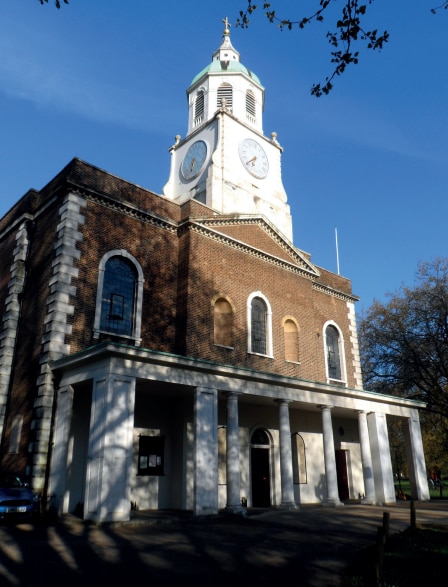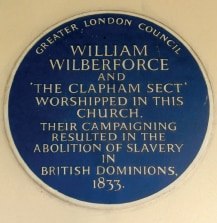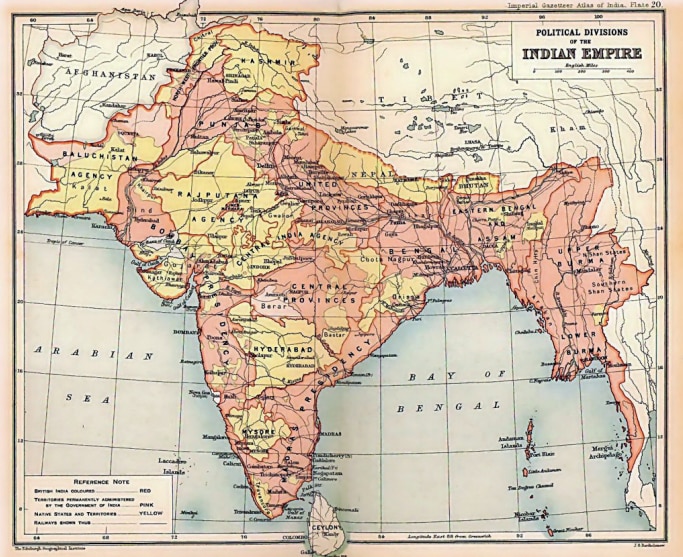Tahmeed Ahmad, Ahmadiyya Archive & Research Centre

Looking back at the 18th century, one cannot help but notice how rapidly Christianity was spreading throughout the world, especially in British India.
The East India Company’s rule began in 1757, but it was not until 1813 that proper missionary works were allowed in India. Any sort of missionary activity was restricted to such a degree that one would deem it banned. To understand the origin of the Christian missionary movements in India one has no choice but to look back at its founders, the Clapham Sect.
The Clapham sect or “saints” – as they were called during the Georgian era – were a close-knit group of well-connected and prosperous evangelicals. (Days that changed the world, p. 114) They are most commonly known for their campaigns against slavery, resulting in slavery bans throughout the British dominion but few know of another important campaign and aim of theirs; the crusade in India.
As the East India Company was establishing itself in India it was careful not to give way for any Christian missionary presence. Lord Macartney put it nicely at the court of China in 1793 by saying; “The English […] have no priest or chaplain with them, as have other European nations”. (Saints in politics: The ‘Clapham Sect’ and the growth of freedom, p. 65)
Members of the deeply religious Clapham sect were abhorrent by the stance their Christian government had taken. So they took it upon themselves to change the parliament’s view, needless to say, it was a task far more difficult than anticipated.
It took many a failed attempt from the “saints” before any real progress was seen – these were at times individual, but mostly joint efforts. The first attempt was made by Charles Grant, an influential Scotsman. He had served as a member of parliament and the chairman of the East India Company in later years.
Grant had the realisation of establishing Christian missions in India during the early years of his service. His first scheme came to life in 1784, when he was inquiring about the possibility of establishing missions. He even managed to make contact with John Wesley, the founder of Methodism, but Mr Wesley ultimately had no faith in Grant’s methods. (Saints in Politics, p. 69)
Grant did not give up on his idea of having missions under the sanction of the civil government. He began writing to like-minded individuals back in England, hoping for support, among whom he was most interested in Rev Charles Simeon and William Wilberforce. David Brown was a newly arrived Calcutta chaplain who was helping Grant with his “Proposal for Establishing a Protestant Mission in Bengal”. (Chaplains of the East India Company, 1601–1858, p 109)
Grant writes:
“Our hopes are particularly fixed on Mr Wilberforce […] It is to his influence alone that we hope the minister will regard a project, and ask for it the countenance of majesty.” (Memoirs of Simeon, p79)
Although Grant’s initial efforts in India had failed to bear fruits, he gained something far more precious, the long-lasting friendship of William Wilberforce. Grant returned to England after spending eight years in India, making acquaintances with the likes of Henry Thornton and even moving to Clapham. (Saints in Politics, p. 70)
The first real opportunity came in 1793 with the renewal of the East India Company’s charter. Charles Grant began working with Zachary Macaulay and James Stephen, both influential statesmen and anti-slavery activists, writing the script Wilberforce was going to present to the parliament.
Wilberforce archived great success, to begin with however, the directors of the East India Company were quick to put a stop to it, crushing any hopes the Clapham saint might have had. Wilberforce writes records in his journals:
“The East India directors and proprietors have triumphed […] all my clauses were last night struck out on the third reading of the bill, and […] twenty millions of people […] are left […] to the providential protection of Brama.” (Life of Wilberforce, p. 27)

The Kentish Gazette (Tuesday 28 May 1793) reported:
“Mr Wilberforce’s cause for sending missionaries to India was the next objected to. It was opposed by Mr Hussey, Mr Dundas, Mr Fox, and the Master of the Roll. Mr Wilberforce withdrew his motion. The whole of the bill was at length gone through with, and passed.”
The Clapham might have lost the battle, but in their eyes, the war was far from over. The charter of 1793 had been an experiment and allowed them to learn from their mistakes. It had become clear that a task of such a calibre required more manpower.
As the rest of Clapham had begun focusing on Africa, namely Sierra Leone, of which Zachary Macaulay was the governor, Rev Charles Simeon was working on other plans.
It was in 1796 that Simeon, now a member of the Eclectic Society, proposed a discussion between the Eclectics that would lead to the foundation of the Church Mission Society. The question was: “With what propriety, and in what mode, can a mission be attempted to the heathen from the Established Church?” (Memoirs of Simeon, p. 111)
As many from the Clapham sect were members of the Eclectic Society, it would not be wrong to say that they inspired and motivated each other. It wasn’t long before Simeon brought the same discussion to his other friends in Clapham. Regular mention of discussion on the subject is found in the journals of Wilberforce.
Foundation of the Church Mission Society
Discussions continued and no real action was taken until 12 April 1799 at the Eclectic Society. The foundation for a new missionary society was held in the very same room that the London Missionary Society had been founded four years earlier. The only representatives of Clapham at this meeting were Charles Elliott and John Venn.
Wilberforce was requested to be president, but he declined the request, instead, he and Charles Grant were made vice-presidents. Henry Thornton was the treasurer and John Venn was appointed chairman of the committee. Rev Charles Simeon and Zachary Macaulay would not be part of the committee because of various reasons. The society was first named “Society for Mission to Africa and the East” and then later named “Church Mission Society”.
With the foundation of the Church Mission Society, preparations once again went underway for the 1813 charter. Wilberforce, Grant and Venn met with the archbishop, presenting their plans. The archbishop had originally been avoiding them for more than a year, but finally took up his courage to face them. He too eventually promised to support them. (Early history of C.M.S, p. 58)
Henry Martyn (not Henry Martyn Clark), known as “Simeon’s spiritual son” became the first volunteer and departed for India. Meanwhile, Clapham was making other preparations. Wilberforce and Grant made sure that John Shore was appointed as the Governor-General of India and later the next year Charles Grant was elected as Director of the East India Company.
Grant used his new position to make sure to appoint suitable men as chaplains, who in return helped pave the way for Christianity in India. One, in particular, was Claudius Buchanan, who helped stimulate greater interest among the English. He returned to England in 1808 to join his brethren in their “crusade”.
Wilberforce showed no sign of slowing down either in his efforts to propagate the Christian faith. He helped establish the bible society or what is better known as “British and Foreign Bible Society” in March 1804. An account from his diary during the early days of the formation reads:
“Hughes, Reyner and Grant breakfast with me, on Bible Society formation.” (Diary belonging to Wilberforce, 5 April)
In 1812 Wilberforce began to move far more aggressively, he interviewed the prime minister, stirred up the clergy and composed an article for the Christian Observer. (Life of Wilberforce IV, pp. 10-16). He was not fighting alone as Macaulay, Grant and the rest of Clapham were all busy at work.
The rest of 1812 was filled with various assemblies and meetings through their Missionary Society, attracting members of parliament and other esteemed gentlemen. As the dates for the charter loomed closer, the stage was set for Wilberforce and Clapham to stand their ground in the face of the East India Company.
Much could be said on the proceedings of the parliament and the debates that took place later on. However, such lengthy discussions might not suit an article of this size. In summary, it became clear over the course of time that the majority was still siding with the East India Company, making the Saints rely more than ever on the same methods as used during their anti-slavery campaigns.
They used the interviews of Wilberforce, public opinion and petitions to push their Christian campaign. Letters were sent all over England, asking them to stand alongside them and sign petitions in their cause. It is against no one’s understanding that names like Wilberforce and Henry Thornton had a great effect on the receivers of these letters. Gaining more than half a million signatures and 837 petitions. (Saints in Politics, pp. 84-92)
The Leeds Mercury (Saturday 15 May 1813) reported:
“The General petition, from the inhabitants of Halifax and its neighbourhood, praying that in the new Charter of the East India Company provision, may be made for the legal protection and tolerance, of Christian Teachers of every denomination, so long as they as they are peaceable and orderly, and comprising other objects connected with the free addition of the Christian religion into our East India Empire.”
Saunders’s News-Letter (Wednesday 24 February 1813) wrote:
“House of Commons, Feb 19.
“Mr Wilberforce presented a Petition from the Scots Society for the propagation of the Gospel in the East, under any change in the Company’s Charter.”
The tides were turning in favour of the Clapham in the last days of the debate. The final nail in the coffin for the British East India Company would be the debate on 22 June 1813. All the representatives from Clapham would gather, but the one to outshine them all would be William Wilberforce who gave, arguably, one of the greatest speeches of his career.

Success to preach Christianity in India
They had done it again and opened the door to the Christian faith in India. The Charter Bill was read out on several occasions in the coming days; however, the point of discussing was most of the time the 13th resolution of the bill.
Many company officials began opposing it, but it was too little and too late, this time around, the Clapham sect had become victorious.
Time flew by and thanks to the efforts of Wilberforce and his friends, Christianity began rapidly spreading throughout India. The charter taking place in 1833 would come to further expand Christian influence in India. This success gained by the missionaries in India helped devolve and increase the nation’s interest in religion, proof of which can be found in the various newspapers at the time.
Friend of India and Statesman (11 May 1871) reported:
“The Calcutta Missionary Conference has arranged to take a very detailed census of protestant Christians and Christian agencies at the end of next year, in order to supplement the necessarily meagre information which will be supplied by the official enumeration. It will not be surprising if the number of 350,000 is considerably exceeded. In 1852 the number was about 113,000 in India and Ceylon. In 1862 this number was nearly doubled rising to 154,000 in India and Ceylon, and to 214,000 in India, Ceylon and Burma.”
Cheltenham Mercury (21 March 1874) wrote:
“If the present rate of increase was continued, by the year 2001 at least 135,000,000 of people would be converted.”
Widnes Examiner (1 April 1893) said:
“[…] the transformation from heathen to Christian will be affected in India in less than half the time that separates Christ from Constantine.”
Edinburgh Evening News (23 May 1905) reported:
“As to the quantity of conversions in India, we have Government census report, which shows that the number of native Christians rose from 1 ¼ million in 1872 to 2-3 million in 1901. As to the quality of these converts there is abundant evidence to numerous instances showing the reality and tenacity of their faith and the general rise in the standard of morality which is characteristic of the native Christian community.”
The Messiah who broke the cross
It was in the face of such mighty waves that Hazrat Mirza Ghulam Ahmadas the Promised Messiah and Mahdi fought back through the pen. It did not take too long before he came face-to-face with the now mighty Clapham sect in the form of the Church Mission Society. The most famous encounter would be The Holy War, a 15-day debate between Hazrat Mirza Ghulam Ahmadas and Dr Henry Martyn Clark.
However, mentioning just one debate out of the countless debates, leaflets, articles, books and the open challenges produced by the Promised Messiahas is far from doing any justice to the part he played in bringing the Christian crusade to its knees.
Nevertheless, I am of the opinion that the vital and prominent role of Hazrat Mirza Ghulam Ahmadas the Promised Messiah and Mahdi, the defender of Islam is deserving of an article of its own, perhaps some other time.

